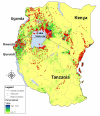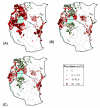An updated atlas of human helminth infections: the example of East Africa
- PMID: 19589144
- PMCID: PMC2714505
- DOI: 10.1186/1476-072X-8-42
An updated atlas of human helminth infections: the example of East Africa
Abstract
Background: Reliable and updated maps of helminth (worm) infection distributions are essential to target control strategies to those populations in greatest need. Although many surveys have been conducted in endemic countries, the data are rarely available in a form that is accessible to policy makers and the managers of public health programmes. This is especially true in sub-Saharan Africa, where empirical data are seldom in the public domain. In an attempt to address the paucity of geographical information on helminth risk, this article describes the development of an updated global atlas of human helminth infection, showing the example of East Africa.
Methods: Empirical, cross-sectional estimates of infection prevalence conducted since 1980 were identified using electronic and manual search strategies of published and unpublished sources. A number of inclusion criteria were imposed for identified information, which was extracted into a standardized database. Details of survey population, diagnostic methods, sample size and numbers infected with schistosomes and soil-transmitted helminths were recorded. A unique identifier linked each record to an electronic copy of the source document, in portable document format. An attempt was made to identify the geographical location of each record using standardized geolocation procedures and the assembled data were incorporated into a geographical information system.
Results: At the time of writing, over 2,748 prevalence surveys were identified through multiple search strategies. Of these, 2,612 were able to be geolocated and mapped. More than half (58%) of included surveys were from grey literature or unpublished sources, underlining the importance of reviewing in-country sources. 66% of all surveys were conducted since 2000. Comprehensive, countrywide data are available for Burundi, Rwanda and Uganda. In contrast, information for Kenya and Tanzania is typically clustered in specific regions of the country, with few records from areas with very low population density and/or environmental conditions which are unfavourable for helminth transmission. Information is presented on the prevalence and geographical distribution for the major helminth species.
Conclusion: For all five countries, the information assembled in the current atlas provides the most reliable, up-to-date and comprehensive source of data on the distribution of common helminth infections to guide the rational implementation of control efforts.
Figures




References
-
- Muller R. Worms and human disease. 2. Wallingford: CABI Publishing; 2002.
-
- Brooker S, Bundy DAP. Soil-transmitted helminths (geohelminths) In: Cook GC, Zumla AI, editor. Manson's Tropical Diseases. 22. London: Elsevier; 2008. pp. 848–853.
-
- Hotez PJ, Bundy DAP, Beegle K, Brooker S, Drake L, de Silva N, Montresor A, Engels D, Jukes M, Chitsulo L, Chow J, Laxminarayan R, Michaud C, Bethony J, Oliveira R, Xiao SH, Fenwick A, Savioli L. Helminth Infections: soil-transmitted helminth infections and schistosomiasis. In: Jamison DT, Breman J, Measham AR, Alleyne G, Claeson M, Evans DB, Jha P, Mills A, Musgrove P, editor. Disease Control Priorities in Developing Countries. New York: Oxford University Press; 2006. pp. 467–497.
-
- Keiser J, Utzinger J. Efficacy of current drugs against soil-transmitted helminth infections: systematic review and meta-analysis. JAMA. 2008;299:1937–1948. - PubMed
-
- Taylor-Robinson DC, Jones AP, Garner P. Deworming drugs for treating soil-transmitted intestinal worms in children: effects on growth and school performance. Cochrane Database Syst Rev. 2007:CD000371. - PubMed
Publication types
MeSH terms
Grants and funding
LinkOut - more resources
Full Text Sources
Medical

